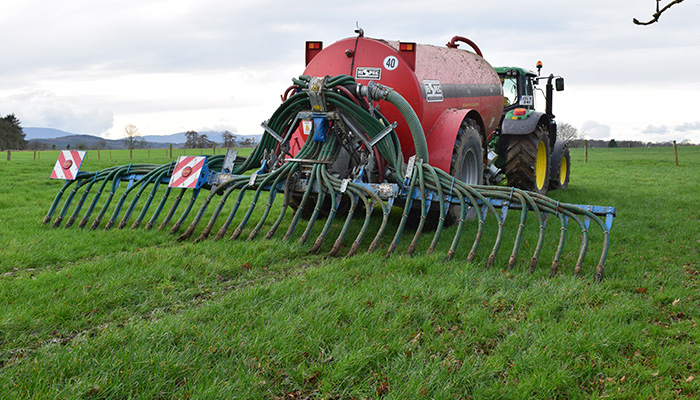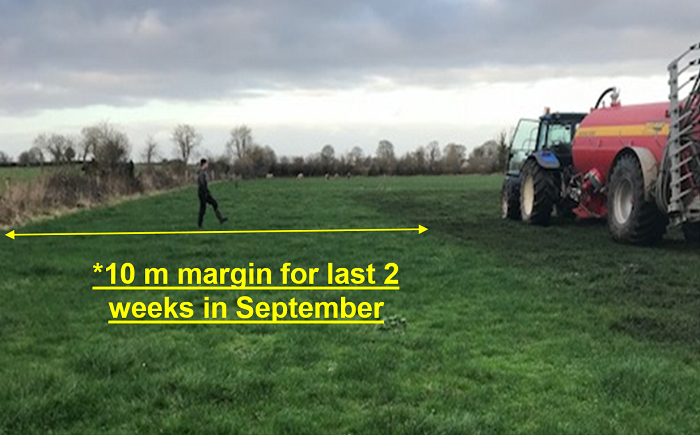14 January 2025
Focus on ground conditions and weather before spreading slurry

With farmers in Zone A now permitted to spread slurry, ASSAP Programme Manager, Noel Meehan shares key advice on how best to maximise the use of slurry for growing crops, and minimise its impact on the environment.
When spreading slurry, it is important to remember that weather and ground conditions can have a significant impact on nutrient being lost to water. Spreading slurry on fields that are frozen or snow covered, waterlogged, flooded or likely to flood is prohibited by the regulations. The reason being, adding slurry to fields under these conditions greatly increases the likelihood that the nutrients from slurry will be lost to water – either by overland flow in the case of saturated soils or by leaching to ground water.
When ground conditions are suitable, it is important to check the weather forecast as slurry should not be spread when heavy rainfall is forecast, as this can also lead to soil saturation and nutrient losses.
Permitted slurry spreading dates:
- Farmers in Zone A– spanning Carlow, Cork, Dublin, Kildare, Kilkenny, Laois, Offaly, Tipperary, Waterford, Wexford and Wicklow – can spread organic manures, such as cattle slurry or farmyard manure, from January 13th.
- Zone B, for which organic manure applications can start on January 16th, encompasses the counties of Clare, Galway, Kerry, Limerick, Longford, Louth, Mayo, Meath, Roscommon, Sligo and Westmeath.
- While for farmers in Zone C, for which the counties of Donegal, Leitrim, Cavan and Monaghan are included, can begin the application of organic manures from February 1st.
- 10 m margin applies on all farms for 2 weeks after opening of spreading period.
While many farmers will be able to hold off on spreading slurry until later in the spring when conditions are more suitable, others will need to spread slurry due to tanks being full. Farmers that find themselves under pressure to spread slurry should examine if they have enough slurry storage in place or if there is clean rain water entering tanks and impacting storage. Ask your advisor for help with this and take action if there is a shortage.
Farmers should also consider the following:
Contractors
Make slurry contractors aware of any water features that may be present in the fields that slurry is being applied and to ensure that slurry is kept back the correct distance, see Table 1 for more information.
When to apply
When organic fertilisers are applied has a large influence on the uptake of nutrients by plants and the potential for losses to waters. Farmers need to be aware of weather conditions when applying organic fertilisers. A consistent soil temperature of 6˚C and preferably rising will mean that grass is growing and has the potential to take up the nutrients applied.
Soil Moisture Content
Another essential factor is the soil moisture content. Is the soil saturated or can tractor work occur without causing structural damage to the soil? Soil that is close to or at saturation point will lead to surface water runoff if there is additional rainfall. Checking the soil moisture content of the field and the weather forecast is important prior to applying organic fertilisers.
This is especially important when using the umbilical slurry spreading system. This system is particularly high risk to water quality if used incorrectly, as it allows slurry to be spread when a slurry tanker wouldn’t be able to travel on land due to ground conditions. While this system does reduce soil compaction, it should not be used on saturated soils as it would pose a risk of nutrient loss to waters.
Location
The fields that slurry is applied to should be chosen carefully. These should be the fields that have a requirement for P and K and with a good pH. They should also be the drier fields on the farm, ideally with no drainage system in place and away from streams and rivers.
Figure 1: 10m buffer zone being adhered to in the final two weeks of the spreading period

Fields that have high connectivity to the drainage network or fields with critical source areas (CSAs) should be avoided until later in the spring to lower the risk of nutrient loss to water.
Table 1: Buffer margin for spreading of organic fertilisers from waters
| Water body / Feature | Slurry/FYM/Soiled water |
|---|---|
| Water Supply > 100m³ or > 500 people | 200m |
| Water Supply > 10m³ or > 50 people | 100m |
| Water Supply < 10m³ or < 50 people | 25m |
| Lake shoreline | 20m |
| Exposed cavernous or karstified limestone features (e.g. swallow holes) | 15m |
| Any surface watercourse where the slope towards watercourse is >10% | 10m |
| All other surface waters * | 5m* |
* Distance is 10m for 2 weeks before and 2 weeks after the closed period for spreading organic manures
Rates
It is important to match the rates of application of organic fertilisers to the growth rates of the grass/crop. This is especially important in the early spring period where growth rates are at their lowest. Applying slurry at rates greater than crop demand means that nutrient is available to be washed away into the drainage network or leached to groundwater. Lower application rates of organic fertilisers are recommended in early spring.
Teagasc has developed a Slurry Calibration Tool, allowing farmers to input tank size, working width, time to empty and target application rate in order to calculate the most appropriate forward speed. Access the Slurry Calibration Tool here.
Find out more about the Teagasc ASSAP Programme here.
The above was adapted for use on Teagasc Daily from the article titled: ‘Significant loss of nutrients to water during the closed period’, which was first published in the Irish Farmers Journal Signpost Programme focus.
